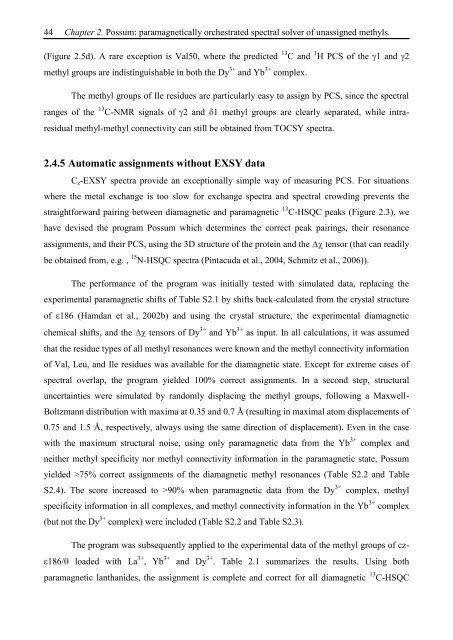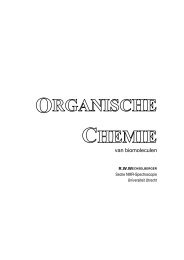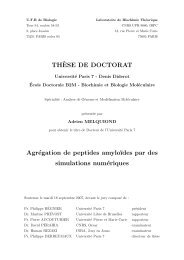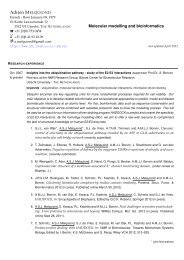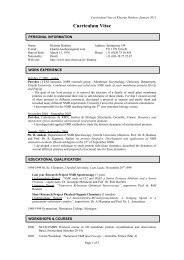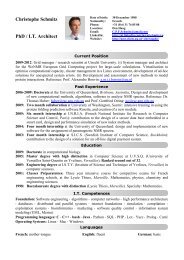Thesis Title: Subtitle - NMR Spectroscopy Research Group
Thesis Title: Subtitle - NMR Spectroscopy Research Group
Thesis Title: Subtitle - NMR Spectroscopy Research Group
You also want an ePaper? Increase the reach of your titles
YUMPU automatically turns print PDFs into web optimized ePapers that Google loves.
44 Chapter 2. Possum: paramagnetically orchestrated spectral solver of unassigned methyls.<br />
(Figure 2.5d). A rare exception is Val50, where the predicted 13 C and 1 H PCS of the 1 and 2<br />
methyl groups are indistinguishable in both the Dy 3+ and Yb 3+ complex.<br />
The methyl groups of Ile residues are particularly easy to assign by PCS, since the spectral<br />
ranges of the 13 C-<strong>NMR</strong> signals of 2 and 1 methyl groups are clearly separated, while intra-<br />
residual methyl-methyl connectivity can still be obtained from TOCSY spectra.<br />
2.4.5 Automatic assignments without EXSY data<br />
Cz-EXSY spectra provide an exceptionally simple way of measuring PCS. For situations<br />
where the metal exchange is too slow for exchange spectra and spectral crowding prevents the<br />
straightforward pairing between diamagnetic and paramagnetic 13 C-HSQC peaks (Figure 2.3), we<br />
have devised the program Possum which determines the correct peak pairings, their resonance<br />
assignments, and their PCS, using the 3D structure of the protein and the tensor (that can readily<br />
be obtained from, e.g. , 15 N-HSQC spectra (Pintacuda et al., 2004, Schmitz et al., 2006)).<br />
The performance of the program was initially tested with simulated data, replacing the<br />
experimental paramagnetic shifts of Table S2.1 by shifts back-calculated from the crystal structure<br />
of 186 (Hamdan et al., 2002b) and using the crystal structure, the experimental diamagnetic<br />
chemical shifts, and the tensors of Dy 3+ and Yb 3+ as input. In all calculations, it was assumed<br />
that the residue types of all methyl resonances were known and the methyl connectivity information<br />
of Val, Leu, and Ile residues was available for the diamagnetic state. Except for extreme cases of<br />
spectral overlap, the program yielded 100% correct assignments. In a second step, structural<br />
uncertainties were simulated by randomly displacing the methyl groups, following a Maxwell-<br />
Boltzmann distribution with maxima at 0.35 and 0.7 Å (resulting in maximal atom displacements of<br />
0.75 and 1.5 Å, respectively, always using the same direction of displacement). Even in the case<br />
with the maximum structural noise, using only paramagnetic data from the Yb 3+ complex and<br />
neither methyl specificity nor methyl connectivity information in the paramagnetic state, Possum<br />
yielded >75% correct assignments of the diamagnetic methyl resonances (Table S2.2 and Table<br />
S2.4). The score increased to >90% when paramagnetic data from the Dy 3+ complex, methyl<br />
specificity information in all complexes, and methyl connectivity information in the Yb 3+ complex<br />
(but not the Dy 3+ complex) were included (Table S2.2 and Table S2.3).<br />
The program was subsequently applied to the experimental data of the methyl groups of cz-<br />
186/ loaded with La 3+ , Yb 3+ and Dy 3+ . Table 2.1 summarizes the results. Using both<br />
paramagnetic lanthanides, the assignment is complete and correct for all diamagnetic 13 C-HSQC


